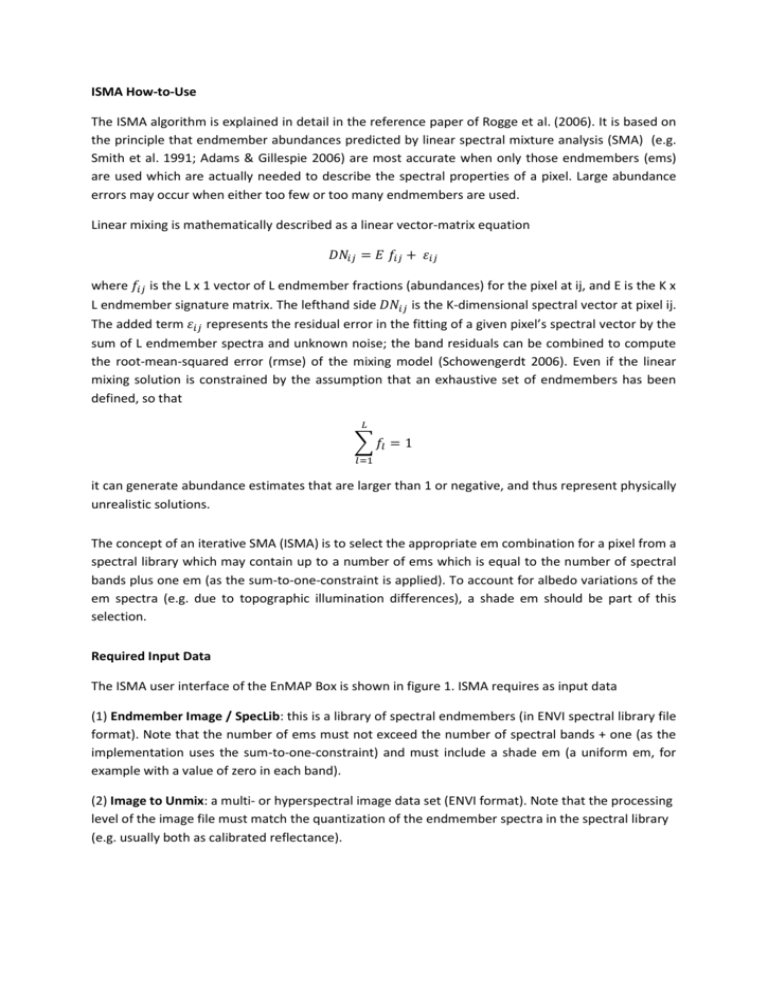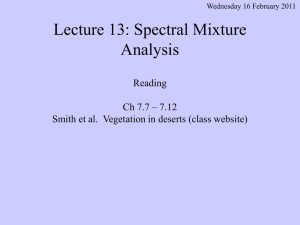ISMA How-to-Use The ISMA algorithm is explained in detail in the
advertisement

ISMA How-to-Use The ISMA algorithm is explained in detail in the reference paper of Rogge et al. (2006). It is based on the principle that endmember abundances predicted by linear spectral mixture analysis (SMA) (e.g. Smith et al. 1991; Adams & Gillespie 2006) are most accurate when only those endmembers (ems) are used which are actually needed to describe the spectral properties of a pixel. Large abundance errors may occur when either too few or too many endmembers are used. Linear mixing is mathematically described as a linear vector-matrix equation 𝐷𝑁𝑖𝑗 = 𝐸 𝑓𝑖𝑗 + 𝜀𝑖𝑗 where 𝑓𝑖𝑗 is the L x 1 vector of L endmember fractions (abundances) for the pixel at ij, and E is the K x L endmember signature matrix. The lefthand side 𝐷𝑁𝑖𝑗 is the K-dimensional spectral vector at pixel ij. The added term 𝜀𝑖𝑗 represents the residual error in the fitting of a given pixel’s spectral vector by the sum of L endmember spectra and unknown noise; the band residuals can be combined to compute the root-mean-squared error (rmse) of the mixing model (Schowengerdt 2006). Even if the linear mixing solution is constrained by the assumption that an exhaustive set of endmembers has been defined, so that 𝐿 ∑ 𝑓𝑙 = 1 𝑙=1 it can generate abundance estimates that are larger than 1 or negative, and thus represent physically unrealistic solutions. The concept of an iterative SMA (ISMA) is to select the appropriate em combination for a pixel from a spectral library which may contain up to a number of ems which is equal to the number of spectral bands plus one em (as the sum-to-one-constraint is applied). To account for albedo variations of the em spectra (e.g. due to topographic illumination differences), a shade em should be part of this selection. Required Input Data The ISMA user interface of the EnMAP Box is shown in figure 1. ISMA requires as input data (1) Endmember Image / SpecLib: this is a library of spectral endmembers (in ENVI spectral library file format). Note that the number of ems must not exceed the number of spectral bands + one (as the implementation uses the sum-to-one-constraint) and must include a shade em (a uniform em, for example with a value of zero in each band). (2) Image to Unmix: a multi- or hyperspectral image data set (ENVI format). Note that the processing level of the image file must match the quantization of the endmember spectra in the spectral library (e.g. usually both as calibrated reflectance). Figure 1: ISMA user interface Parametrizing the ISMA For each pixel in the image, the ISMA is executed in two parts: 1) Iterative unmixing to remove ems one at a time: the iteration starts with the full em set; from the unmixing solution the em with the lowest abundance (positive or negative) is removed, excluding the shade em which is retained for all iterations. As long as the number of ems is > 1, a new unmixing solution is computed with the remaining ems. This is repeated until only one em and shade remain. (2) Determining the optimal em set by analyzing the change in rmse as a function of the number of endmembers: this is based on the examination of changes in the rmse over all iterations. The scope is to determine the critical iteration that uses too few ems. The rmse should be variable but low, due to overfitting which occurs as long as the number of ems is larger than required and the actual ems that comprise the mixture have not been discarded; it will, however, substantially increase as soon as one of the actual ems is removed during the iteration process because then too few ems are available to effectively model the mixture. This is the “critical iteration” and can be defined by two alternative modes. Option 1 This the original approach proposed by Rogge et al. (2006): the critical iteration is determined automatically by calculating the change in the rmse (Δ𝑟𝑚𝑠𝑒) starting from the last iteration until Δ𝑟𝑚𝑠𝑒 is below a preset threshold (DRMS-Threshold). Δ𝑟𝑚𝑠𝑒 is calculated as Δ𝑟𝑚𝑠𝑒 = 1 − (𝑟𝑚𝑠𝑒𝑖𝑡−1⁄𝑟𝑚𝑠𝑒𝑖𝑡 ) where 𝑟𝑚𝑠𝑒𝑖𝑡 is the nth iteration rms value. The search process begins with the last iteration. ISMA is further controlled by specifying that the Δ𝑟𝑚𝑠𝑒 value must remain below the threshold for a predetermined number of successive iterations (Number of RMS-Differences to consider) before the process is halted. Figure 2: RMSE-Profile (15 iterations) from running ISMA with 16 ems (including shade) on a hyperspectral image (HyMap, 124 spectral bands) This implies that two control parameters must be specified: DRMS-Threshold: critical threshold value (default = 0.5) Number of lagged Iterations: number of successive iterations below threshold (default = 2) The value of 0.5 for DRMS-Threshold then suggests that the increase from 𝑟𝑚𝑠𝑒𝑖𝑡−1 to 𝑟𝑚𝑠𝑒𝑖𝑡 must be more than 50 % of 𝑟𝑚𝑠𝑒𝑖𝑡 to be identified as critical iteration. Since the search is descending from the last iteration the optimal em set is the first of the number of RMS-Differences (= successive iterations) which fulfill the condition; this limits the probability of false detections owing to intermediate or spurious breaks. For this parameter a minimum value of 2 is recommended when working with hyperspectral images; for multispectral data (Landsat OLI, Sentinel-2) the value of 2 is inappropriate and should be replaced by 0 or 1. This strategy for identifying the critical iteration is usually quite efficient when applying the ISMA to hyperspectral data where the first iterations tend to produce rmse sequences which are fluctuating more or less steadily around low values before the models become deficient (figure 2). Figure 3: RMSE-Profile (6 iterations) from running ISMA with 7 ems (including shade) on a multispectral image (Landsat ETM+, 6 spectral bands) However, depending on the type of spectral libraries used it may also occur that the rmse sequence is more or less increasing gradually before the reaching the breakpoint (figure 1). This may even become more typical when using ISMA for unmixing spectra with a smaller number of spectral bands. The number of successive iterations to be considered will then be substantially restricted, basically to nlags = 1 (figure 3). Option 2 This strategy provides an alternative. It is based on fitting a regression line through the initial range of the rmse values (i.e. that specific part of the sequence where the rmse is fluctuating around a low base level, owing to overfitting effects). The critical iteration is then determined by comparing the difference between 𝑟𝑚𝑠𝑒𝑖𝑡 and the rmse which is produced by the regression model (𝑟𝑚𝑠𝑒𝑚𝑜𝑑 ) for the corresponding iteration; if this difference (normalized to 𝑟𝑚𝑠𝑒𝑚𝑜𝑑 ) becomes smaller than the pre-defined threshold (DRMS-Threshold) the critical iteration is found. Figure 3: RMSE-Profile (15 iterations) from running ISMA with 16 ems (including shade) on a hyperspectral image (HyMap, 124 spectral bands) with a regression line fitted to rmse[4] tormse[11]. This implies that for this option three parameters must be specified: DRMS-Threshold: critical threshold value (default = 0.5) Index Range from … to … : index of the first and last iteration to be considered for modelling the rmse reference level by a linear regression. The second method for identifying the critical iteration lends itself particularly well in case that images with a limited number of spectral channels are used, such as for example Landsat-OLI or the forthcoming Sentinel-2 system. Option 3 The last option is primarily meant to serve for testing purposes. It is therefore not designed to identify the critical iteration but produces a user-defined number of em-fractions for each pixel. Accordingly, the user only specifies a single parameter, i.e. the Number of Retained Endmembers: number of ems to be retained for each pixel Available Outputs The standard output of ISMA requires a base name specified by the user. All outputs (fixed suffixes) are appended to this base name. The following products are generated once the corresponding boxes are activated: Fractions: Multi-band image of endmember abundances (fractions). If options 1 or 2 are selected, the number of output bands corresponds to the number of available ems; fractions of inactive ems are assigned a value of zero. Residuals: Multi-band image of band residuals (i.e. the difference between the input spectral signature and the modeled spectrum which results from applying the estimated fractions to the corresponding em-combination). The number of output bands always corresponds to the number of spectral channels of the input image. Modelled: The modeled spectral signature which results from applying the estimated fractions to the corresponding em-combination. RMSE: A single-channel image presenting the RMSE of the selected em-combination. Additional products are available for documenting what is termed the “elimination history”, i.e. the subsequent elimination of ems until finally one em + shade are retained. RMSE: Multi-band image of the RMSE for each em-combination of the iterative elimination procedure; the number of bands corresponds to the number of endmembers (excluding shade). Minimum Fractions: Multi-band image of the minimum fraction for each em-combination of the iterative elimination procedure; the number of bands corresponds to the number of endmembers (excluding shade). Index: The index of the selected em-combination. Dark Fractions: Multi-band image of the dark (i.e. shade) fraction for each em-combination of the iterative elimination procedure; the number of bands corresponds to the number of endmembers (excluding shade). References Adams, J.B., & Gillespie, A.R. (2006). Remote sensing of landscapes with spectral images: A physical modeling approach: Cambridge University Press. Rogge, D.M., Rivard, B., Zhang, J., & Feng, J. (2006). Iterative spectral unmixing for optimizing perpixel endmember sets. IEEE Transactions on Geoscience and Remote Sensing, 44, 3725-3736. Schowengerdt, R. A. (2006). Remote sensing: models and methods for image processing: Academic Press. Smith, M.O., Ustin, S.L., Adams, J.B., & Gillespie, A.R. (1990). Vegetation in deserts: I. A regional measure of abundance from multispectral images. Remote Sensing of Environment, 31, 1-26





